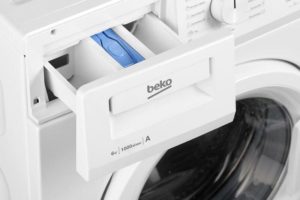 Beko washing machine It is characterized by simplicity and reliability in operation. However, like any other equipment, after many years of work, the machine can fail at the most inopportune moment. If your Beko washing machine does not drain, you can try to solve the problem yourself.
Beko washing machine It is characterized by simplicity and reliability in operation. However, like any other equipment, after many years of work, the machine can fail at the most inopportune moment. If your Beko washing machine does not drain, you can try to solve the problem yourself.
Causes
If The machine does not drain water and does not spin things out, then you should first find out the reason. In this situation, the reasons are divided into two types:
- Problem during operation:
- clogged drain hose, filter or pipe;
- incorrectly connected hose;
- Wrong choice of washing program.
- Breaking:
- breakdown of the pressure switch - the water level sensor in the machine, which is responsible for timely draining;
- failure of the electronic drain system;
- electric pump failure.
Troubleshooting Yourself

Initially, you should check whether the washing mode is selected correctly. Every Beko washing machine has a cycle that washes delicate fabrics and woollens without spinning. If it is installed, then after washing, you must separately start the process of draining the water. To do this, press the “Start” or “Start” key.
You also need to check whether the drain hose is connected to the machine correctly and assess its condition. If it is too bent or pinched, the water will not drain.In addition, the hose may be clogged with debris. In this case, you should clean it. The length of the drain hose plays an important role when draining water. If a hose longer than 1.5 m is installed, the pump will not be able to pump water over a long distance.
Also, the machine may not drain water cause of filter clogging. In Beko washing machines, the filter is located behind a small protective panel on the right side. You need to remove the filter by turning the holder to the right. Prepare a basin in advance, because water also accumulates in the filter compartment. Afterwards, the garbage disposal must be cleaned and rinsed under the tap.
When using the machine for a long time, the drain pipe also needs to be cleaned. You can get to it from the bottom of the machine, armed with a screwdriver. The pipe is held on by three fasteners that need to be loosened. Having separated the part, we clean it with a small brush, and then install it back. If you find cracks or holes in the drain pipe, it must be replaced with a new one.
To prevent washing machine maintenance, you can also clean the filter installed on the water supply. You can find it on the back panel of the machine, where the hose is attached. Cleaning it prevents the accumulation of sand and rust from tap water.
There is also a drain pump on the back of the washing machine. If the machine hums strangely when washing and refuses to drain the water, then you should pay attention to it. Beko washing machines are equipped with a self-diagnosis function and often detect a breakdown of the pump in the pump responsible for draining the water. And the lit H5 key on the control panel notifies you of this. However, in case of minor failures, the controller does not respond. For example, the impeller in a pump may become loose and fall off, which can be detected by a humming sound.
How to drain the water yourself

What should I do if pressing the buttons fails to drain the water? You can also do this manually. Exists several ways to empty the drum of water:
- Water can be drained through the hole after removing the drain filter of the machine. To do this, unscrew the filter cover and tilt the machine. Substituting the container, you need to drain all the water and then take out the laundry.
- If water does not flow through the filter, then the problem is a blockage. It will need to be cleaned.
- Beko washing machines come with an additional drain hose. So, if the first options do not work, you can run the hose into the drum and drain the water.
Troubleshooting
If the water does not drain from the washing machine, then the reasons, in addition to clogging, may be serious damage. At this stage, it is better to contact professional technicians for high-quality diagnostics and further repairs. There are three main reasons why a washing machine does not drain water:
- Malfunction in the drain pump. It can be installed on the impeller. As stated above, it will either not move or may even break if overloaded. In this case, the technician will replace the pump with a new one.
- The problem may also be hidden in the control module. If the control module fails, the signal is not sent from the board and the pump does not begin to drain water. The technician needs to disassemble the machine and fix problems with the programmer.
- If the drum is frequently overloaded, the water level sensor may fail.. The sensor must be replaced, because if it breaks down, it does not detect the water level and sends a signal to the control board to indicate the end of the wash.
There are many reasons why water does not drain from a washing machine, and each of them has its own nuances. It is not always possible to install them yourself, much less repair them. Therefore, it is advisable to contact a specialist. Of course, using the above steps, you can clean the filter and hoses of the machine yourself. If the procedure does not fix the problem, then it’s time to entrust it to a professional.









